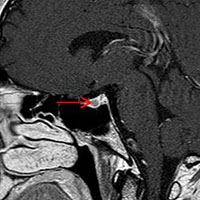Keywords
Thyroid nodule, thyrotropinoma, hyperthyroidism, hemithyroidectomy, somatostatin analogues.
Abstract
Objectives: We report the unusual case of a patient with a thyrotropinoma, discovered after a hemithyroidectomy for a suspicious thyroid nodule, and its therapeutic challenges.
Materials and methods: In a patient who underwent hemithyroidectomy for cold thyroid nodule, hyperthyroid symptoms persisted, despite stopping levothyroxine treatment. Further investigation was carried out through the following laboratory tests: thyroid-stimulating hormone (TSH) test; free thyroxine (fT4) test; and the thyrotropin releasing hormone (TRH) test. A pituitary magnetic resonance imaging (MRI) scan and genetic analysis was also carried out. The test results confirmed the diagnosis of a thyrotropinoma.
Results: Treatment with long-acting somatostatin analogues normalised thyroid hormones and symptoms of hyperthyroidism.
Conclusion: The diagnostic approach to the thyroid nodule should include a detailed clinical and biochemical examination. Initial biochemical evaluation by TSH alone does not allow detecting inappropriate TSH secretion that may increase the risk of thyroid malignancy. In case of a thyrotropinoma, the ideal treatment consists of combined care of central and peripheral thyroid disease.
References

Views: 1173
HTML downloads: 461
PDF downloads: 308
Table 1 downloads: 0
Figure 1 downloads: 0
Figure 2 downloads: 0
Published:
2015-07-29
Issue:
Vol. 2 No. 5 (2015)
(view)










